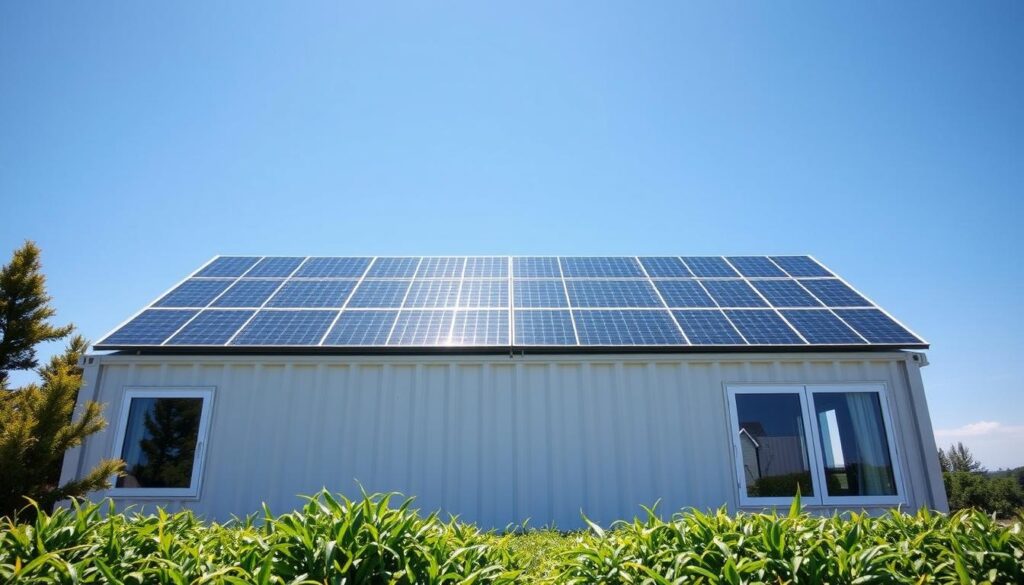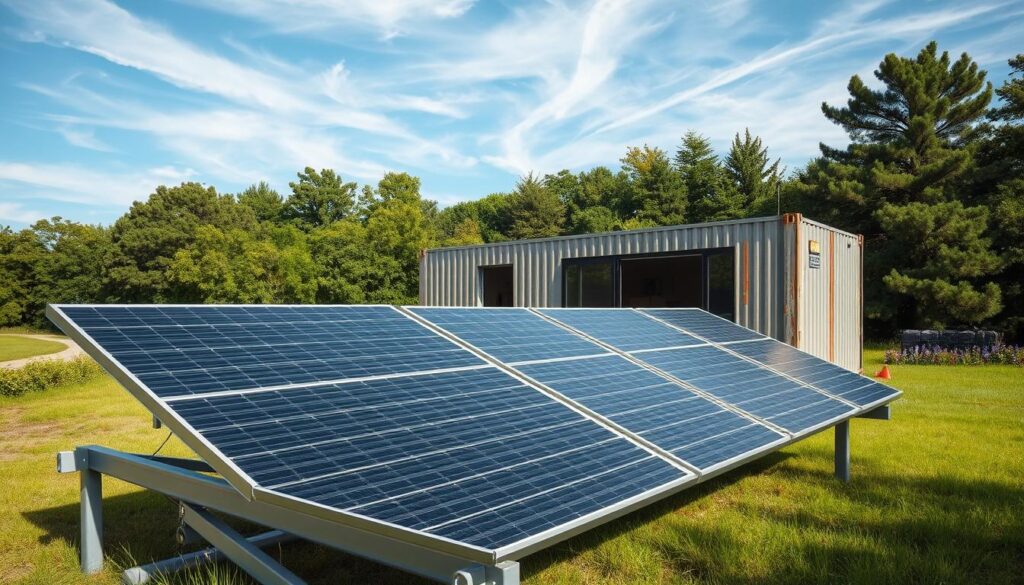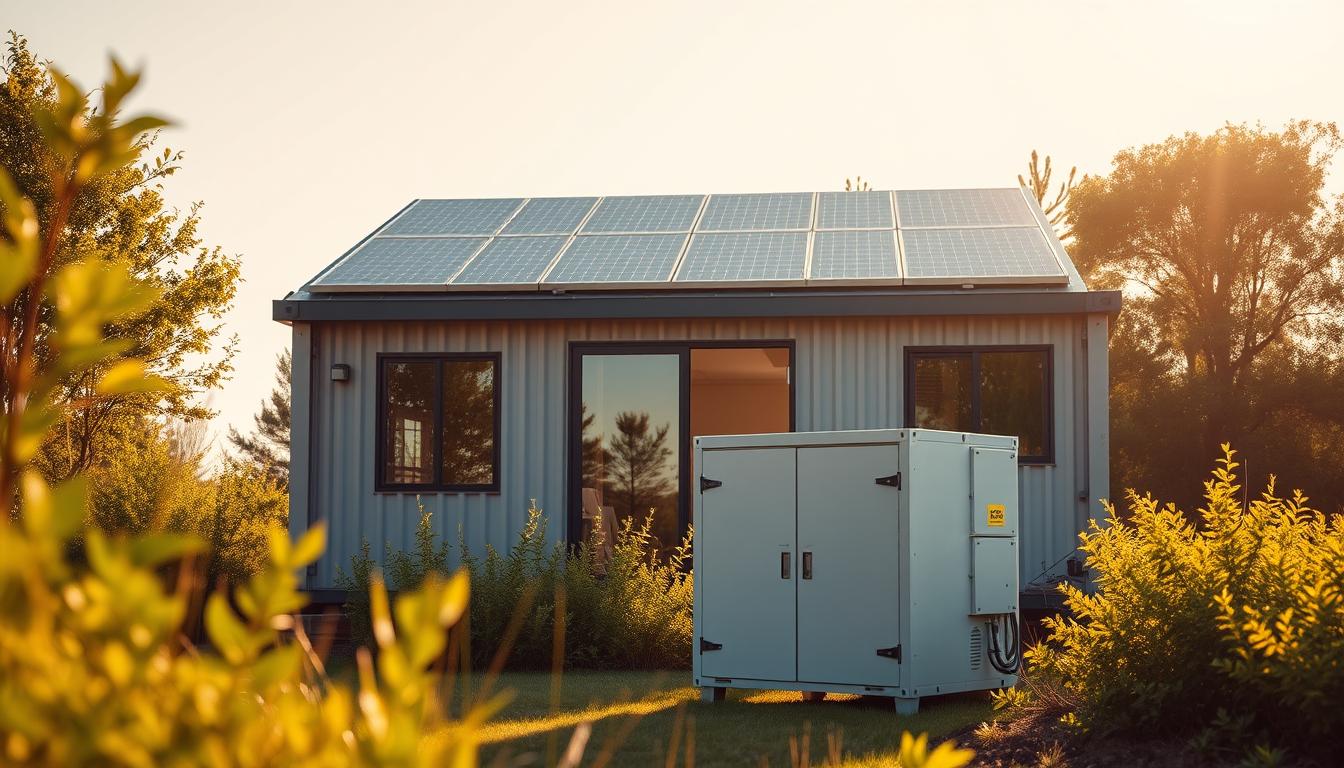Did you know that integrating solar panels into container homes can significantly reduce reliance on traditional power grids and lower energy costs? According to Bond Containers, harnessing solar energy is a crucial step towards energy independence and minimizing environmental impact. By capturing sunlight and converting it into electricity, solar panels offer a clean and renewable energy source.
As the world shifts towards sustainable living, container home solar solutions are becoming increasingly popular. By installing solar panels, homeowners can not only reduce their carbon footprint but also increase their property value. For more information on the benefits of solar energy, you can visit Bond Containers article on harnessing the power of the sun.
Key Takeaways
- Reduce reliance on traditional power grids with solar panel installation.
- Lower energy costs and increase property value with container home solar solutions.
- Minimize environmental impact by harnessing renewable solar energy.
- Benefit from energy independence with solar power for your container home.
- Enhance your home’s value with a sustainable energy solution.
The Benefits of Solar Power for Container Homes
Embracing solar power can revolutionize the way container homes operate, offering a sustainable and renewable energy solution. As the world shifts towards more eco-friendly living options, container homes are at the forefront of this movement, with solar power being a key component.
Solar power brings numerous benefits to container homes, enhancing their appeal as modern, sustainable dwellings.
Energy Independence and Off-Grid Living
One of the most significant advantages of solar power for container homes is the ability to achieve energy independence. By harnessing solar energy, homeowners can reduce their reliance on the grid and enjoy off-grid living. This is particularly beneficial for those living in remote areas where traditional energy infrastructure may be lacking.
As Bond Containers emphasizes, solar power reduces reliance on fossil fuels, lowers carbon footprint, and provides energy independence. This aligns with the growing demand for off-grid container home energy solutions.
Environmental Impact and Sustainability
Solar power significantly reduces the environmental impact of container homes by utilizing a clean, renewable energy source. This shift towards sustainable power for container living is crucial in minimizing the carbon footprint associated with traditional energy consumption.
“The use of solar power in container homes represents a significant step towards sustainable living.”
Cost Savings and Return on Investment
In addition to environmental benefits, solar power also offers substantial cost savings. By generating their own energy, container homeowners can significantly reduce their utility bills. Moreover, the initial investment in solar panels can yield a considerable return on investment over time.
| Benefits | Description | Impact |
|---|---|---|
| Energy Independence | Reduced reliance on the grid | Enhanced off-grid living capabilities |
| Environmental Sustainability | Clean, renewable energy source | Reduced carbon footprint |
| Cost Savings | Reduced utility bills | Significant return on investment |
By adopting solar power, container homeowners can enjoy a more sustainable, cost-effective, and independent living experience.
Understanding Your Container Home’s Energy Needs
To harness solar energy effectively, understanding your container home’s energy requirements is key. This involves a thorough assessment of your daily power consumption, the insulation and climate of your container home, and planning for future expansions or upgrades.
Calculating Your Daily Power Consumption
Start by identifying all the appliances you plan to use in your container home. Make a list of their power ratings and estimated usage hours. For instance, LED lights consume less power than traditional bulbs, and energy-efficient appliances can significantly reduce overall consumption.
- Lighting: LED bulbs, 9W, 5 hours/day
- Refrigerator: 100W, 8 hours/day
- Laptop: 50W, 4 hours/day
Accounting for Container Home Insulation and Climate
The insulation of your container home and the local climate play crucial roles in determining your energy needs. Proper insulation can reduce heating and cooling demands, while extreme climates may require additional energy for temperature control.
Insulation Tips:
- Use high-quality insulation materials like foam board or spray foam.
- Seal all gaps and cracks to prevent heat loss or gain.
Planning for Future Expansion and Upgrades
When designing your solar energy system, consider future needs and potential upgrades. This forward-thinking approach ensures your system remains efficient and effective over time.
Essential Appliances vs. Luxury Items
Differentiating between essential appliances and luxury items is crucial. Essentials like refrigerators and lighting are must-haves, while luxury items like hot tubs or additional TVs can be considered based on your energy budget.
By carefully assessing your energy needs and planning accordingly, you can create a solar energy system that is both efficient and tailored to your lifestyle.
Assessing Your Container Home’s Solar Potential
The journey to solar-powered container living begins with assessing your home’s solar potential. This crucial step ensures that your container home can efficiently harness solar energy, maximizing the benefits of your solar panel installation.
Evaluating Sun Exposure and Container Orientation
The orientation of your container home plays a significant role in determining its solar potential. Ideally, containers should be oriented to face south to capture the maximum amount of sunlight throughout the day. Evaluating sun exposure involves assessing any factors that might impact the amount of sunlight your container home receives.
Dealing with Shade and Obstructions
Shade from trees, buildings, or other obstructions can significantly reduce the efficiency of your solar panels. It’s essential to evaluate the shading on your container home throughout the day and across different seasons. Using tools like solar pathfinders can help identify the best placement for solar panels to minimize shade impact.
Roof Space and Structural Considerations for Shipping Containers
Shipping containers have limited roof space, which can affect the number of solar panels you can install. It’s crucial to assess the structural integrity of your container home to ensure it can support the weight of the solar panels. Consulting with a professional can help determine the best solar panel configuration for your container home.
Alternative Mounting Options for Limited Space
For containers with limited roof space, alternative mounting options such as ground-mounted solar arrays or solar canopies can provide additional space for solar panels. These solutions can be particularly useful for container homes with significant energy needs or those located in areas with high energy demands.
Essential Components of a Container Home Solar System
For a container home to run efficiently on solar power, it’s vital to understand the core components of a solar energy system. A well-designed solar system can provide energy independence, reduce environmental impact, and offer significant cost savings.
Solar Panels: Types and Efficiency Ratings
Solar panels are the heart of any solar energy system, converting sunlight into electrical energy. There are several types of solar panels, including monocrystalline, polycrystalline, and thin-film panels, each with its own efficiency ratings and cost considerations. Monocrystalline panels, for instance, are known for their high efficiency and durability.

Inverters: Converting DC to AC Power
Inverters play a crucial role in converting the direct current (DC) power generated by solar panels into alternating current (AC) power, which is usable in homes. High-quality inverters ensure reliable energy conversion and are essential for a stable solar energy system.
Battery Storage Options for Container Living
Battery storage is vital for storing excess energy generated during the day for use at night or during periods of low sunlight. Options include lead-acid batteries, lithium-ion batteries, and other advanced battery technologies. Lithium-ion batteries are popular for their high efficiency and long lifespan.
| Battery Type | Efficiency | Lifespan |
|---|---|---|
| Lead-Acid | 80% | 5-7 years |
| Lithium-Ion | 95% | 10-15 years |
Charge Controllers and Monitoring Systems
Charge controllers regulate the flow of energy from the solar panels to the battery bank, preventing overcharging and ensuring the system’s longevity. Monitoring systems allow homeowners to track their energy production and consumption in real-time, optimizing their energy usage.
“A well-designed solar energy system is not just about generating power; it’s about creating an efficient, reliable, and sustainable energy solution for your container home.”
By understanding and integrating these essential components, container homeowners can enjoy a reliable, efficient, and sustainable solar energy system tailored to their needs.
How to Add Solar Power to a Container Home: Step-by-Step Process
The process of adding solar power to a container home involves several key steps that ensure a safe and efficient installation. By following these steps, you can enjoy the benefits of renewable energy and reduce your reliance on public utilities.
Planning and Obtaining Necessary Permits
Before starting your solar installation project, it’s crucial to plan carefully and obtain the necessary permits. This involves assessing your energy needs, evaluating your container home’s solar potential, and checking local building codes and regulations. According to Bond Containers, “Understanding local regulations is key to a smooth installation process.” Ensure you have all required permits before commencing work.
- Assess your energy needs and solar potential
- Check local building codes and regulations
- Obtain necessary permits
Specialized Mounting Solutions for Container Roofs
Container roofs require specialized mounting solutions to secure solar panels safely. Mars provides insights into various mounting systems designed for container homes, emphasizing the importance of durability and weather resistance. When choosing a mounting system, consider factors such as the size and weight of your solar panels, as well as the structural integrity of your container roof.
Wiring and Connection Basics for Metal Structures
Wiring and connecting your solar system requires careful attention to safety and efficiency. When working with metal container structures, it’s essential to ensure proper insulation and grounding to prevent electrical shocks or fires. Use high-quality wiring and connectors suitable for outdoor use, and follow the manufacturer’s instructions for installation.
“Proper grounding and bonding are critical for the safe operation of your solar system.” – National Electric Code
System Testing and Commissioning
Once your solar system is installed, thorough testing and commissioning are necessary to ensure it operates correctly and safely. Check all connections, verify the system’s voltage and current output, and test for any faults or issues. This step is crucial for guaranteeing the performance and longevity of your solar system.
Safety Considerations When Working with Metal Containers
Working with metal containers requires additional safety precautions due to their conductive nature. Always ensure your solar system is properly grounded, and take measures to prevent electrical shock or fire hazards. Wear appropriate personal protective equipment (PPE) during installation, and consider hiring a professional if you’re unsure about any aspect of the process.
By following these steps and considering safety, you can successfully add solar power to your container home, enjoying the benefits of renewable energy and a reduced carbon footprint.
Grid-Tied vs. Off-Grid Systems for Container Homes
When it comes to powering your container home with solar energy, one of the most critical decisions you’ll make is whether to go grid-tied or off-grid. This choice significantly impacts your energy independence, sustainability, and overall cost.
Comparing Initial Costs and Long-Term Benefits
Grid-tied systems are generally less expensive to install because they don’t require battery storage. However, they depend on the grid being available, which might not be the case in remote areas. Off-grid systems, on the other hand, offer energy independence but come with higher upfront costs due to the need for battery storage. When considering long-term benefits, off-grid systems can provide continuous power regardless of grid outages.
Battery Requirements for Off-Grid Container Living
For off-grid container homes, battery storage is crucial. It allows you to store excess energy generated during the day for use at night or during periods of low sunlight. The capacity and type of batteries needed will depend on your energy consumption and the size of your solar array. Deep cycle batteries are typically recommended for off-grid systems due to their ability to handle repeated discharge cycles.
Hybrid Systems: Getting the Best of Both Worlds
Hybrid solar systems offer a compromise between grid-tied and off-grid systems. They allow you to connect to the grid while also having battery storage for backup power during outages. This flexibility can be particularly beneficial for container homes in areas with unreliable grid connections. By investing in a hybrid system, you can enjoy the benefits of both energy independence and grid stability.
In conclusion, the choice between grid-tied, off-grid, and hybrid solar systems for your container home depends on your specific energy needs, budget, and location. Carefully evaluating these factors will help you make an informed decision that aligns with your renewable energy goals.
Solar Power Kits Designed for Container Homes
For container homeowners looking to harness solar energy, pre-packaged and customizable solar power kits offer a convenient and efficient solution. These kits are designed to simplify the process of transitioning to renewable energy, making it accessible even for those with limited DIY experience.
Pre-packaged Solutions for Beginners
Pre-packaged solar power kits are ideal for beginners. They come with all the necessary components, including solar panels, inverters, and battery storage, making it easy to get started with solar energy. Companies like Mars offer comprehensive kits that cater to different energy needs, ensuring a seamless installation process.
Customizable Kit Options for Unique Container Layouts
For container homes with unique energy requirements or layouts, customizable solar power kits provide the flexibility needed. These kits allow homeowners to select specific components that fit their energy consumption patterns, ensuring an optimal solar solution.
Top Recommended Kits for Different Budgets
When choosing a solar power kit, budget is a significant consideration. Here are some top recommendations across different budget categories:
- Budget-friendly: Mars Basic Kit – Offers essential components at an affordable price.
- Mid-range: Mars Pro Kit – Provides a balance between cost and performance, including high-efficiency solar panels.
- Premium: Mars Elite Kit – Includes top-of-the-line components and advanced monitoring systems.
Installation Tips for Container-Specific Kits
When installing solar power kits on container homes, it’s crucial to consider the unique aspects of container structures. Ensure that the mounting system is secure and compatible with the container’s roof. Additionally, proper wiring and connection techniques are vital to avoid any safety hazards. Always follow the manufacturer’s instructions and consider hiring a professional if you’re unsure about any part of the installation process.
Costs and Financing Options for Container Home Solar
Sustainable power for container living through solar energy is not only environmentally friendly but also economically viable in the long run. As you consider this eco-friendly option, understanding the financial aspects is crucial.
Breaking Down Initial Investment Costs
The initial cost of a solar power setup for your container home includes solar panels, inverters, battery storage, and installation costs. These can range from $10,000 to $30,000 or more, depending on your energy needs and system size.
Available Tax Credits and Incentives
The U.S. government offers tax credits for renewable energy investments, which can significantly reduce your upfront costs. For instance, the Solar Investment Tax Credit (ITC) allows you to deduct a percentage of your solar installation costs from your federal taxes.
Financing and Loan Options for Renewable Energy
Various financing options are available, including solar loans and leases. Solar loans allow you to own the system outright, while leases offer lower upfront costs but may have long-term implications.
Calculating Your Return on Investment Timeline
Return on Investment (ROI) Timeline
| System Size | Initial Cost | Annual Savings | ROI Timeline |
|---|---|---|---|
| 3 kW | $15,000 | $500 | 7-10 years |
| 5 kW | $25,000 | $1,000 | 5-7 years |

Maintaining Your Container Home’s Solar System
To ensure your container home’s solar system operates at peak performance, regular maintenance is crucial. Mars emphasizes the importance of regular maintenance for solar energy systems to ensure optimal performance.
Regular Cleaning and Inspection Routines
Regular cleaning of solar panels is essential to remove dirt and debris that can reduce energy production. Inspect your panels regularly for damage or shading issues. Cleaning should be done with a soft brush or cloth and mild detergent to avoid damaging the panels.
Battery Maintenance and Replacement Schedules
Battery maintenance is critical for off-grid solar systems. Check battery levels regularly and ensure proper charging and discharging cycles. Batteries typically need to be replaced every 5-7 years, depending on the type and usage.
Troubleshooting Common Issues in Container Installations
Common issues include faulty inverters, loose connections, and panel damage. Regularly inspect your system for these issues and address them promptly. Monitoring systems can help identify problems early.
Preparing Your System for Extreme Weather
Extreme weather conditions, such as heavy snow or intense heat, can impact your solar system’s performance. Ensure your system is designed to withstand local weather conditions and take precautions such as securing panels and checking wiring.
By following these maintenance tips, you can ensure your container home’s solar system continues to provide reliable renewable energy options for containers.
Conclusion: Powering Your Sustainable Container Lifestyle
As highlighted by Bond Containers, integrating solar power into your container home is a significant step towards achieving a sustainable and energy-independent lifestyle. By harnessing the sun’s energy, you can reduce your reliance on traditional energy sources, lower your utility bills, and minimize your environmental footprint.
To add solar power to your container home, it’s essential to understand your energy needs, assess your home’s solar potential, and choose the right solar system components. Whether you opt for a grid-tied or off-grid system, solar power can provide a reliable and renewable source of energy for your container living.
By adopting sustainable power for container living, you’re not only reducing your impact on the environment, but also creating a more self-sufficient and cost-effective lifestyle. With the right planning and installation, you can enjoy the benefits of solar energy and power your sustainable container lifestyle.

